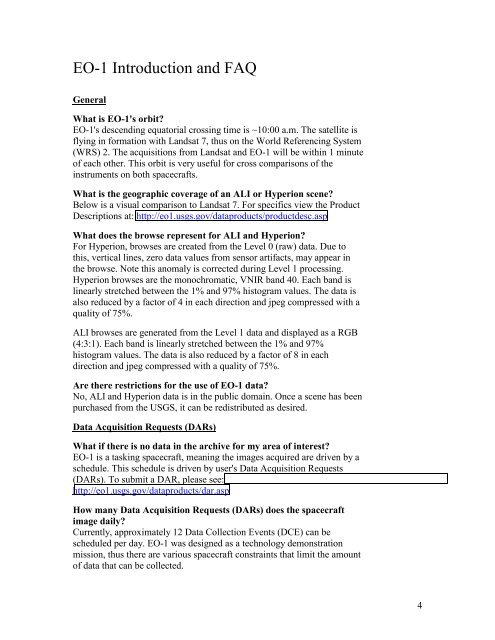You also want an ePaper? Increase the reach of your titles
YUMPU automatically turns print PDFs into web optimized ePapers that Google loves.
<strong>EO</strong>-1 Introduction and FAQGeneralWhat is <strong>EO</strong>-1's orbit?<strong>EO</strong>-1's descending equatorial crossing time is ~10:00 a.m. The satellite isflying in formation with Landsat 7, thus on the World Referencing System(WRS) 2. The acquisitions from Landsat and <strong>EO</strong>-1 will be within 1 minuteof each other. This orbit is very useful for cross comparisons of theinstruments on both spacecrafts.What is the geographic coverage of an ALI or Hyperion scene?Below is a visual comparison to Landsat 7. For specifics view the ProductDescriptions at: http://eo1.usgs.gov/dataproducts/productdesc.aspWhat does the browse represent for ALI and Hyperion?For Hyperion, browses are created from the Level 0 (raw) data. Due tothis, vertical lines, zero data values from sensor artifacts, may appear inthe browse. Note this anomaly is corrected during Level 1 processing.Hyperion browses are the monochromatic, VNIR band 40. Each band islinearly stretched between the 1% and 97% histogram values. The data isalso reduced by a factor of 4 in each direction and jpeg compressed with aquality of 75%.ALI browses are generated from the Level 1 data and displayed as a RGB(4:3:1). Each band is linearly stretched between the 1% and 97%histogram values. The data is also reduced by a factor of 8 in eachdirection and jpeg compressed with a quality of 75%.Are there restrictions for the use of <strong>EO</strong>-1 data?No, ALI and Hyperion data is in the public domain. Once a scene has beenpurchased from the <strong>USGS</strong>, it can be redistributed as desired.Data Acquisition Requests (DARs)What if there is no data in the archive for my area of interest?<strong>EO</strong>-1 is a tasking spacecraft, meaning the images acquired are driven by aschedule. This schedule is driven by user's Data Acquisition Requests(DARs). To submit a DAR, please see:http://eo1.usgs.gov/dataproducts/dar.aspHow many Data Acquisition Requests (DARs) does the spacecraftimage daily?Currently, approximately 12 Data Collection Events (DCE) can bescheduled per day. <strong>EO</strong>-1 was designed as a technology demonstrationmission, thus there are various spacecraft constraints that limit the amountof data that can be collected.4





